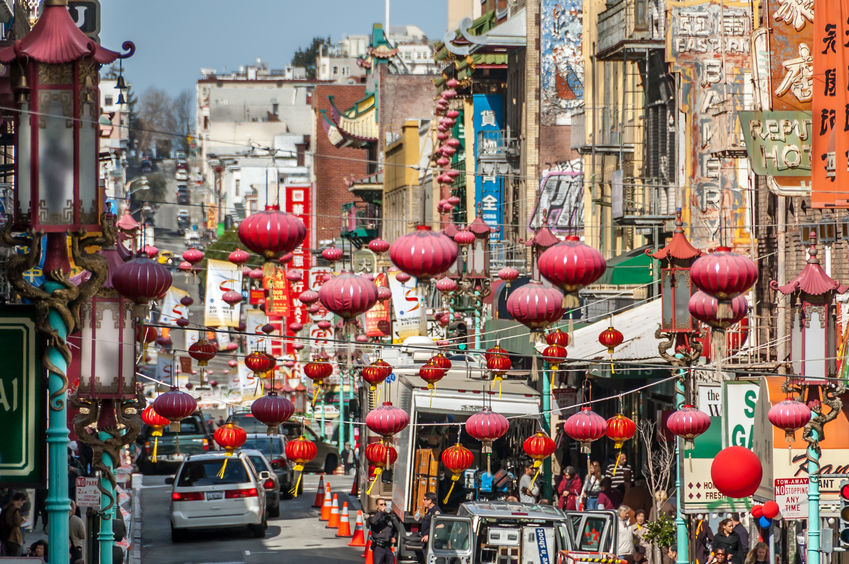
09 Jun A Self-Guided Walking Tour of San Francisco’s Chinatown
]San Francisco boasts one of the most famous Chinatown’s in the entire world. Steeped in history, San Francisco’s Chinatown has been featured in movies, carries significant cultural significance, and is home to a lot of fantastic restaurants.
For these many reasons, tourists from around the world visit Chinatown year-round. Parking in Chinatown is notoriously difficult however. So many prefer to walk when soaking in the sights and sounds of the neighborhood.
Next time you visit the City by the Bay, try our self-guided walking tour of San Francisco’s Chinatown:
San Francisco Chinatown Walking Tour Summary
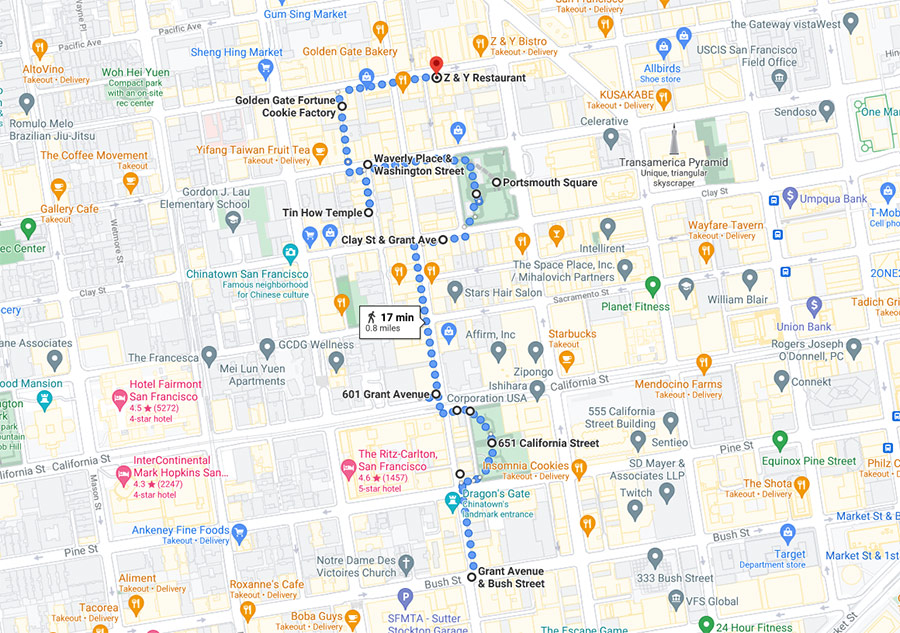
This walk begins at Bush St. and Grant Ave. at the Dragon Gate entrance to Chinatown. Winding through this historic neighborhood, the total distance of the walk is only about 1 mile.
However, to allow for time at all of the listed stops below, give yourself two to three hours to complete this walking tour. And of course save your appetite (and some time) for your lunch or dinner at Z & Y Restaurant at the end.
Starting Point: The Dragon Gate
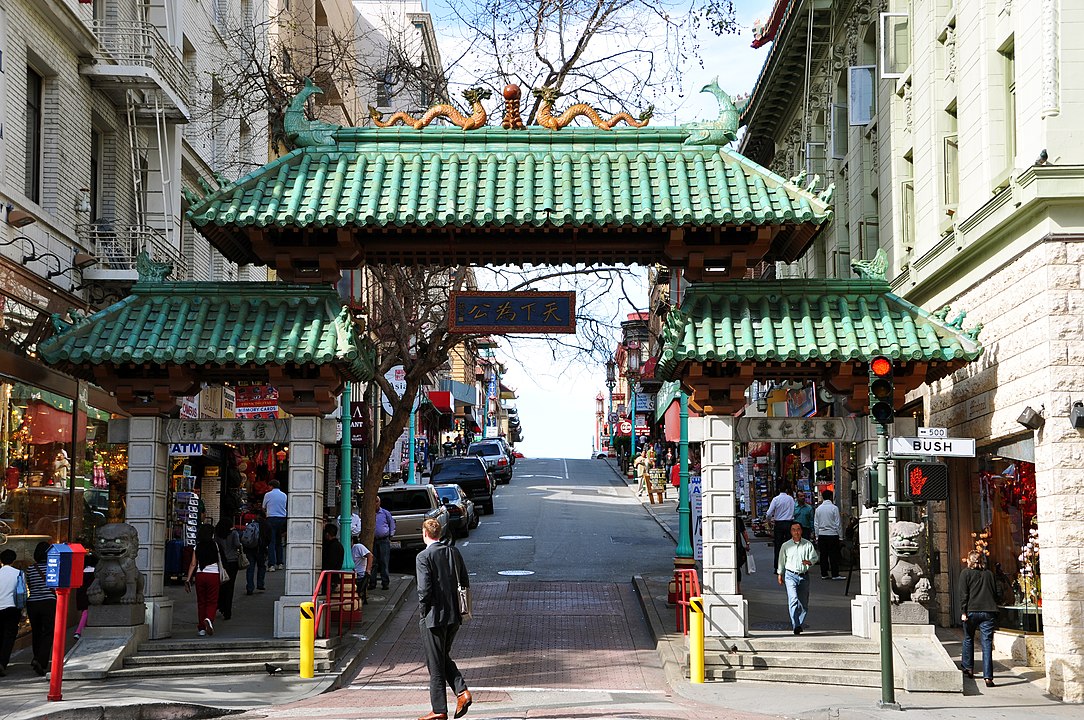
Other than the Golden Gate Bridge, tourists take photos of the Dragon Gate on Grant Ave. as much as any SF attraction. Officially completed in 1970, the Dragon Gate marks the Southern entrance to Chinatown where Grant Ave. meets Bush St.
In the style of many Chinese gateways, the Dragon Gate features three distinct, South-facing portals. The largest center portal spans the roadway while two smaller portals cover a portion of each sidewalk. Constructed from stone, the supporting columns of the structure adhere to the standards of authentic Chinese gateways.
Stone lions guard the smaller East and West portals for pedestrian traffic. Following Chinese tradition, there is one male lion (West side), and one female lion (east side). Fish and dragons adorn the top of the gates, symbolizing prosperity, power, and fertility respectively. Learn more about the architecture and symbolism of the Dragon Gate here. Pass through the gates once you’ve snapped some photos, and continue your walking tour of San Francisco’s Chinatown.
Historic St. Mary’s Square & Cathedral
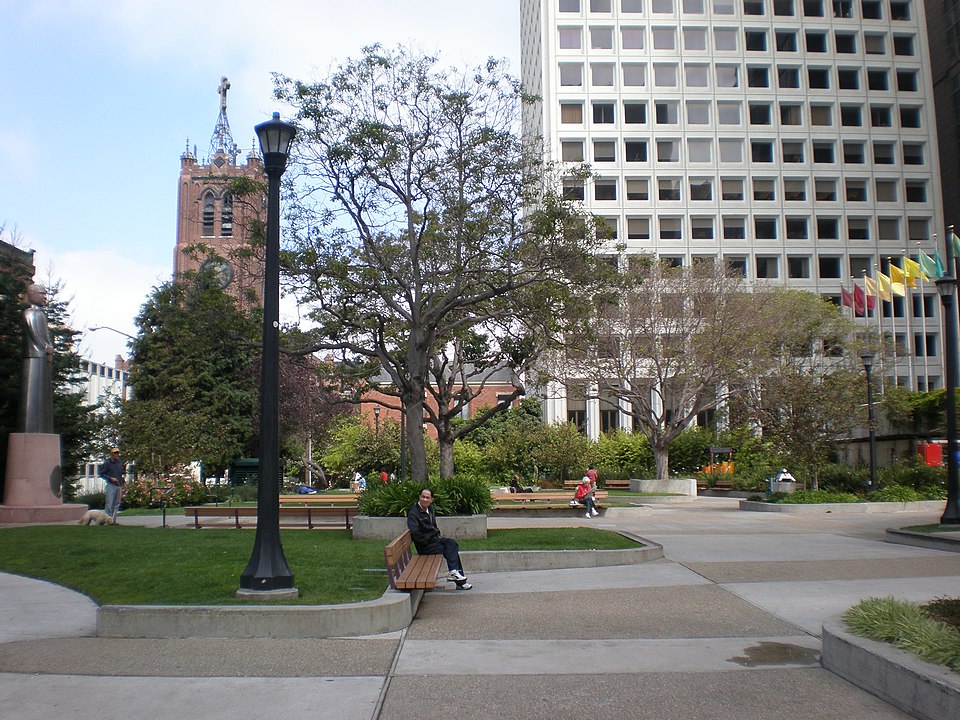
Proceed one block North up Grant Avenue, generally known as the main street of San Francisco’s Chinatown. Then, at the intersection of Pine St., look to the right and you’ll see nearby St. Mary’s Square.
Marking a border between Chinatown and the traditional Financial District, St. Mary’s Square offers a surprising calm and quiet environment. Designed in 1957, the square is actually a rooftop park and garden sitting on top of a parking structure.
In addition to many benches and a children’s park, the square is home to a statue of Sun Yat-sen. Sun was a famous Chinese statesman, though he was later exiled from his home country for his role in the overthrow of the Qing Dynasty. Many now know him as the Father of today’s Communist China.
On the North side of the Square, look across California St. to find the historic Old St. Mary’s Cathedral. It first opened in 1854 as the 1st Catholic cathedral built in San Francisco. The cathedral survived the 1906 earthquake, only to be badly damaged by the subsequent fires. Workers eventually completed extensive renovations and repairs on the structure in 1909, which still stands today.
Authentic Architecture at the Sing Chong Building
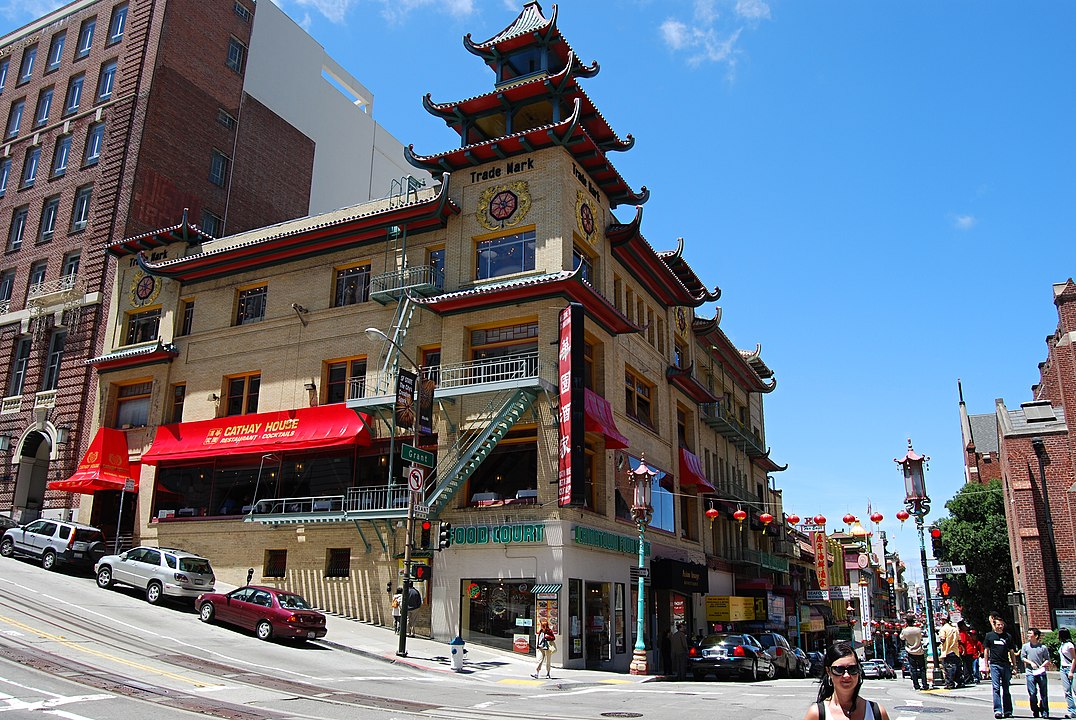
By Pavel Špindler, CC BY 3.0, https://commons.wikimedia.org/w/index.php?curid=54478775
From the Old St. Mary’s Cathedral, turn West and head back across Grant Avenue to find the historic Sing Chong building. Designed by Ross & Burgren, construction on the building began after the Great Earthquake of 1906.
Curbed San Francisco offers insight into the inspiration for the Sing Chong Building, amid a push to relocate Chinatown to what is today the Bayview neighborhood:
“After the 1906 earthquake City Hall smelled an opportunity to banish Chinatown to the fringes, planning to relocate the community to what is now Bayview. But the Chinese Family Associations and the Chinese Consulate refused to budge.
Chinatown merchant Look Tin Eli seized on the idea of hiring non-Chinese architects and contractors to rebuild the neighborhood in homage/pastiche styles of classical Chinese architecture, a bid to increase its appeal as a tourist destination and cultural redoubt.”
Vibrant Grant Avenue to Clay St. & Portsmouth Square
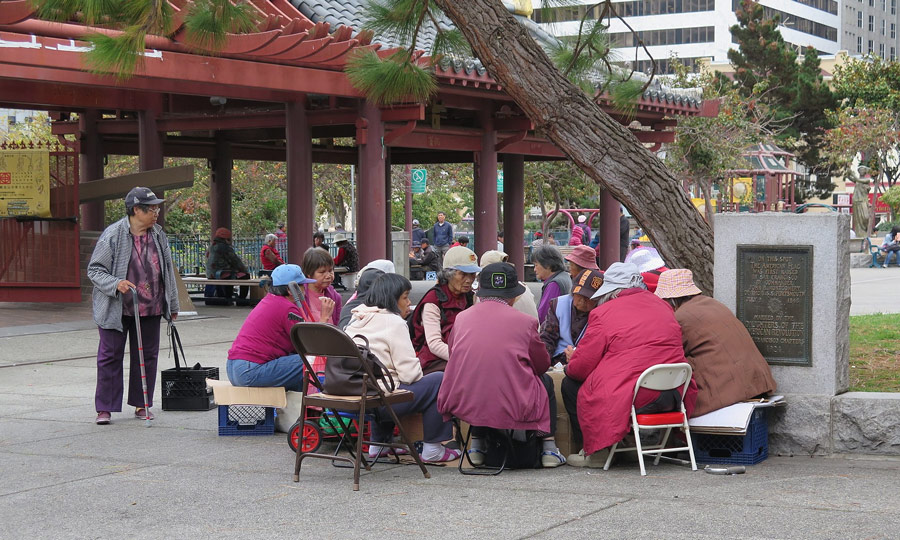
By Gary Stevens – Card Players in Portsmouth Square, SF Chinatown, CC BY 2.0, https://commons.wikimedia.org/w/index.php?curid=68253345
After soaking up the architectural stylings of the Sing Chong Building, continue North up Grant Avenue for two more blocks. During this portion of the walking tour of San Francisco’s Chinatown, enjoy the variety of souvenir shops and traditional markets.
Upon reaching Clay St. turn right where there are typically large murals painted on one or both sides of the street. As of the Summer of 2021, visitors will find a relatively new Bruce Lee mural on the South side of Clay St at Grant Ave:
However, the history of Portsmouth Square pre-dates even the earliest days of the Chinatown neighborhood. According to the San Francisco Department of Recreation and Parks, “It is the location of the first raising of the American flag within San Francisco in 1846, and here in 1848, the discovery of gold was first announced.”
Alley Exploration: The Tin How Temple
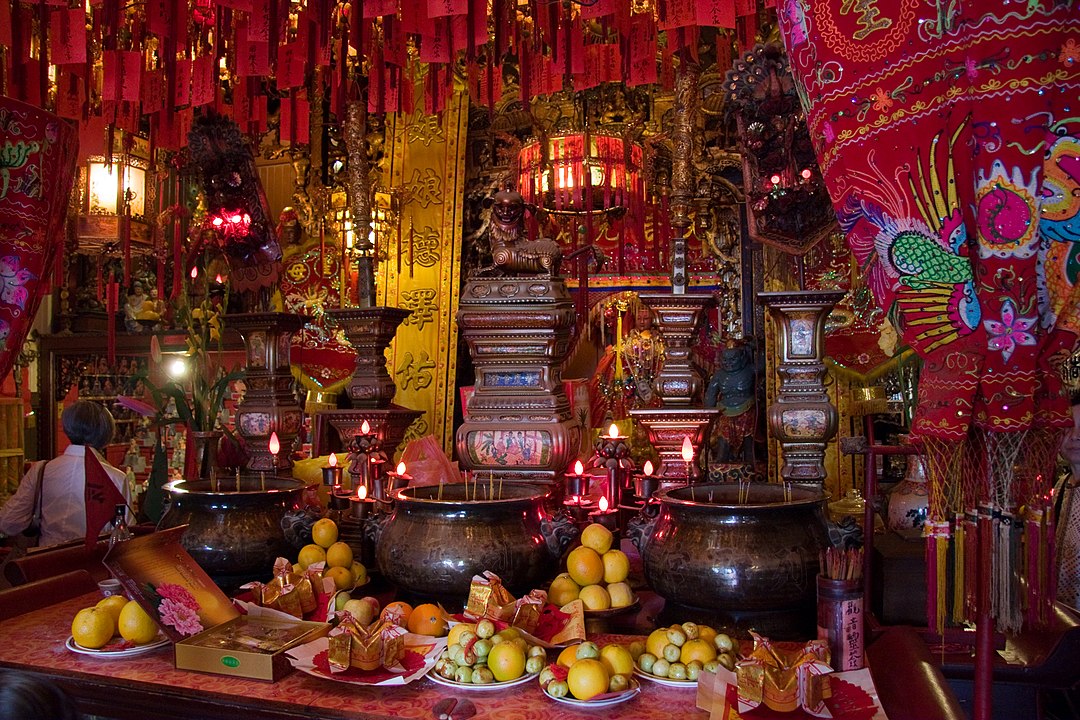
By Ronnie Macdonald from Chelmsford, United Kingdom – Chinatown 22 Buddhist Temple, CC BY 2.0, https://commons.wikimedia.org/w/index.php?curid=25809742
Following your stop in Portsmouth Square, exit on the Washington St. (North) side and then head back uphill (West) and cross Grant Avenue again. Not even a half-block past Grant Ave, turn left to enter one of Chinatown’s many famous alleys, Waverly Place.
Historically, Chinatown’s alleys have a pretty rough reputation. Many associate the alleys with tales of opium dens, houses of prostitutions, and casinos from many decades ago. In truth however, the alleys primarily served as a means to ease population density in Chinatown due to discriminatory policies that largely blocked Chinese from settling in other neighborhoods.
As you walk past a variety of salons, printing shops, florists, acupuncturists, and other business, you might walk right past the nondescript entrance to the Tin How (Or “Tianhou”) Temple. This landmark is the oldest Taoist temple in San Francisco, and the oldest Chinese temple in the United States still in operation. Founded in 1852, much of the temple collapsed in the 1906 Earthquake, but the owners later rebuilt in the same location.
Walk up the stairs to the third floor and enter a room with hanging red lanterns, various shrines and jaw-dropping views of Downtown San Francisco. Photographs are not permitted in the temple, but you may have your fortune read inside if so inclined. A small, but voluntary donation is recommended before leaving as a sign of respect.
A Famous Fortune Cookie Factory
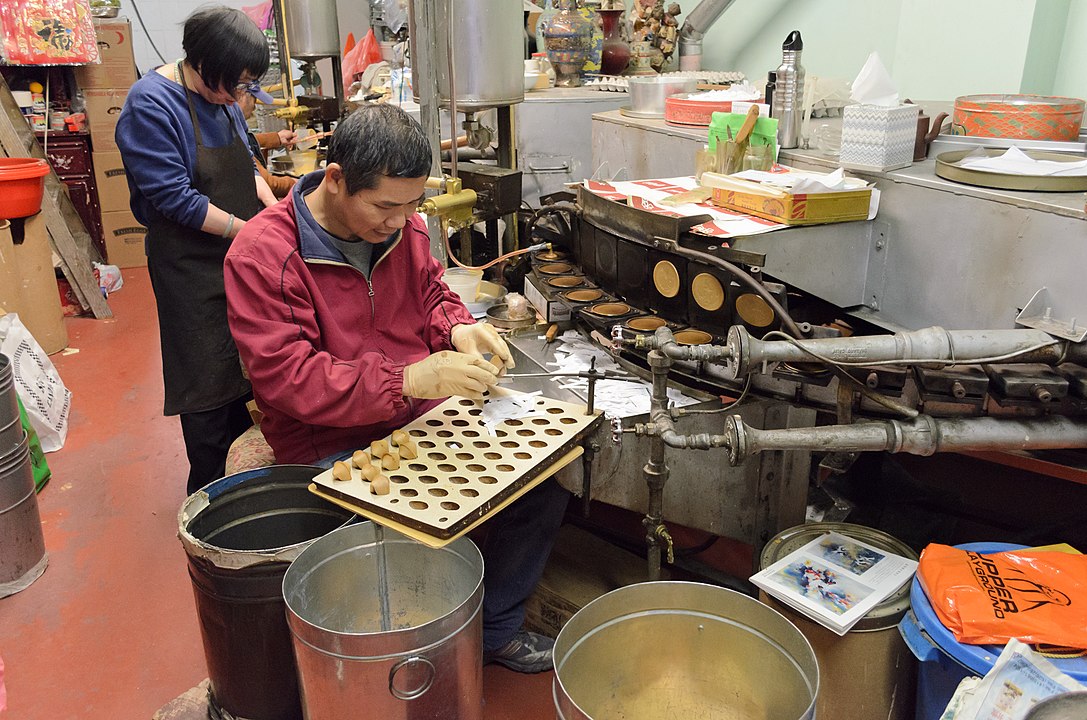
By King of Hearts / Wikimedia Commons / CC-BY-SA-3.0, CC BY-SA 3.0, https://commons.wikimedia.org/w/index.php?curid=50926957
Upon departure from the temple, had back down Waverly Place and return to Washington St. From there, cross the street, turn left, and look for Ross Alley. This very narrow alley is just a few buildings uphill and across the street from Waverly Place.
Near the Jackson St. side of this narrow alley you’ll find the Golden Gate Fortune Cookie Factory. In this building, workers make 10,000 fortune cookies a day by hand. The business opened in 1962 and today offers factor tours, a merchandise store, and more!
The business earned distinction as a “San Francisco Legendary Business” in 2018 and is a favorite of tourists, celebrity and the media. Learn more at the Golden Gate Fortune Cookie Factory website.
Finish with a Sichuan Feast at Z & Y Restaurant
After your day of exploring Chinatown, you deserve a nice meal. Exit the fortune cookie factory and continue down Ross Alley to Jackson St. Once there, turn right on and look for Z & Y Restaurant. Our award-winning restaurant is about a block downhill from Ross Alley at 655 Jackson Street.
With indoor and outdoor dining options, and something on the menu for every palate, you won’t be left unsatisfied. Plan ahead and make reservations online if you can!
Looking for more activity ideas like this walking tour of San Francisco’s Chinatown? Visit our sister restaurant, Chili House SF, and check out their walking tour from the Golden Gate Bridge through the bluffs of the Presidio to their restaurant.







